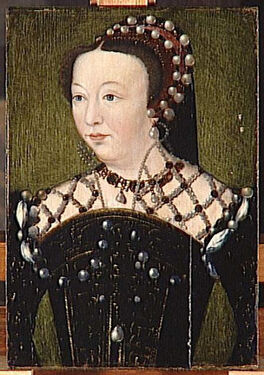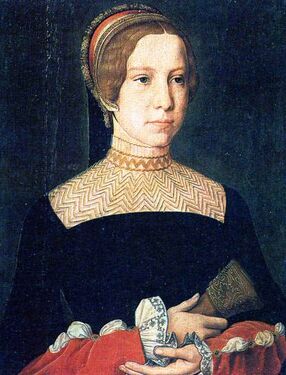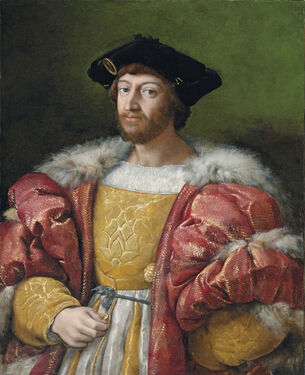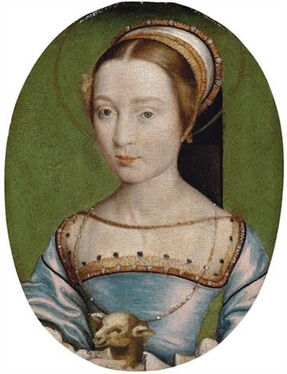Henry III (September 19, 1551 – August 2, 1589), was a monarch of the House of Valois Angouleme who was elected the monarch of the Polish-Lithuanian Commonwealth from 1573 to 1575 and ruled as King of France from 1574 until his death. He was the last French monarch of the Valois dynasty.
Early Life & Childhood[]
Prince Edward Alexander of France was born at the royal Château de Fontainebleau, on September 19, 1551. He was the 4th son & 6th child of King Henry II and Queen Catherine de' Medici. His older brothers were Francis II of France, Charles IX of France, and Louis of Valois. He was made Duke of Angoulême and Duke of Orléans in 1560, then Duke of Anjou in 1566.
He was his mother's favorite; she called him chers yeux ("precious eyes") and lavished fondness and affection upon him for most of his life. His elder brother, Charles, grew to detest him, partially because he resented his better health.
In his youth, Henry was considered the best of the sons of Catherine de' Medici and Henry II. Unlike his father and elder brothers, he had little interest in the traditional Valois pastimes of hunting and physical exercise. Although he was both fond of fencing and skilled in it, he preferred to indulge his tastes for the arts and reading. These predilections were attributed to his Italian mother. At one point in his youth he showed a tendency towards Protestantism as a means of rebelling. At the age of nine, calling himself "a little Huguenot," he refused to attend Mass, sang Protestant psalms to his sister Margaret (exhorting her all the while to change her religion and cast her Book of Hours into the fire), and even bit the nose off a statue of Saint Paul. His mother firmly cautioned her children against such behavior, and he would never again show any Protestant tendencies. Instead, he became nominally Roman Catholic.
Courting a Queen[]
In 1570, discussions commenced to arrange for Henry to court Queen Elizabeth I of England. Elizabeth, almost 37, was expected by many parties in her country to marry and produce an heir. However, nothing came of these discussions. In initiating them, Elizabeth is viewed by historians as having intended only to arouse the concern of Spain, rather than contemplate marriage seriously. The chance of marriage was further blighted by differing religious views (Henry was Catholic, Elizabeth Protestant) and his opinion of Elizabeth. Henry tactlessly made stinging remarks about their 18 year difference in age. Upon hearing (inaccurately) that she limped because of a varicose vein, he called her an "old creature with a sore leg.
King of Poland & Lithuania[]
Following the death of the Polish ruler Sigismund II Augustus on July 7, 1572, Jean de Monluc was sent as the French envoy to Poland to negotiate the election of Henry to the Polish throne in exchange for military support against Russia, diplomatic assistance in dealing with the Ottoman Empire, and financial subsidies. On May 16, 1573, Polish nobles chose Henry as the first elected monarch of the Polish-Lithuanian Commonwealth. The Lithuanian nobles boycotted this election, however, and it was left to the Lithuanian ducal council to confirm his election. Thus the Commonwealth elected Henry, rather than Habsburg candidates, partly in order to be more agreeable to the Ottoman Empire (a traditional ally of France through the Franco-Ottoman alliance) and strengthen a Polish-Ottoman alliance that was also in effect.
At a ceremony before the Paris parliament on September 13, the Polish delegation handed over the "certificate of election to the throne of Poland-Lithuania". Henry also gave up any claims to succession and he "recognized the principle of free election" under the Henrician Articles and the pacta conventa. It was not until January 1574 that Henry was to reach the borders of Poland. On February 21, Henry's coronation was held in Kraków. In mid-June 1574, upon learning of the death of his brother, the king Of France Charles IX, Henry left Poland and headed back to France. Henry's absence "provoked a constitutional crisis" that the Parliament attempted to resolve by notifying Henry that his throne would be lost if he did not return from France by May 12, 1575. His failure to return caused Parliament to declare his throne vacant. The short reign of Henry at Wawel Castle in Poland was marked by a clash of cultures between the Polish and the French. The young king and his followers were astonished by several Polish practices and disappointed by the rural poverty and harsh climate of the country. The Polish, on the other hand, wondered if all Frenchmen were as concerned with their appearance as their new king appeared to be.
Henry meets Louise[]
Princess Louise of Lorraine was the youngest and only surviving child of Nicholas of Lorraine, Duke of Mercoeur, and Countess Marguerite d'Egmont. Louise would first meet Henry in the autumn of 1573, when the Duke of Anjou, was on his way to Krakow, the capital of his new kingdom, Poland-Lithuania. She attracted Henry's interest during a celebration in honor of Henry's election as King of Poland-Lithuania.
Henry's Proposal[]
Following the death of his brother King Charles IX of France, Henry, King of Poland-Lithuania succeeded him as Henry III of France and returned clandestinely to France. Louise was with her family traveling to Reims for Henry's coronation, when Philippe Hurault de Cheverny and Michel Du Guast arrived to make Henry's marriage proposal.
Coronation & a Wedding[]
Henry was officially crowned King of France on February 13, 1575 at Reims Cathedral. Just 2 days later on February 15, 1575 the new King and Princess Louise were married in a grand ceremony at Reims Cathedral. At the end of the month the new Queen of France officially entered Paris with her husband.
Married Life & Heartache[]
Following their grand wedding, Louise immediately fell in love with Henry, a feeling that only deepened despite the difficulties, tragedies, his infidelities and later death. Louise had a very calm personality and accepted her husband's eccentricities such as buying expensive clothes and dressing her up because she was happy to have his attention.
Sadly their marriage would not produce any children, Louise had apparently become pregnant not long after her wedding but miscarried in May 1575, but since no pregnancy announcement was made this is an unconfirmed rumor. The Queen blamed herself for this and as a result became thin and suffered bouts of depression. Between 1579 and 1586, both she and her husband made numerous pious offerings and pilgrimages, especially to Chartres for spa treatments in the hope of having an heir. As a result, since the King's brother had died in 1584 the heir presumptive was the controversial Henry III of Navarre, a fact which placed additional pressure upon both Louise and her husband. In 1584, there were rumors that Henry III would divorce her, but they proved to be untrue. According to Brantôme, Louise was at one point advised by a lady-in-waiting, that because her marriage would not result in children, it would be wise to find another man to father her child, but the Queen took deep offense at this advice and refused to listen.
The Reign of Henry III[]
In 1576, Henry signed the Edict of Beaulieu, which granted many concessions to the Huguenots. His action resulted in the Catholic activist Henry I, Duke of Guise, forming the Catholic League. After much posturing and negotiations, Henry was forced to rescind most of the concessions that had been made to the Protestants in the edict.
In 1584, the King's youngest brother and heir presumptive, Francis, Duke of Anjou, died. Under Salic Law, the next heir to the throne was Protestant Henry of Navarre, a descendant of Louis IX (Saint Louis). Under pressure from the Duke of Guise, Henry III issued an edict suppressing Protestantism and annulling Henry of Navarre's right to the throne.
On May 12, 1588, when the Duke of Guise entered Paris, an apparently spontaneous Day of the Barricades erupted in favor of the Catholic champion. Henry III fled the city. Following the defeat of the Spanish Armada that summer, the king's fear of Spanish support for the Catholic League apparently waned. Accordingly, on December 23, 1588, at the Château de Blois, he invited the Duke of Guise to the council chamber where his brother Louis II, Cardinal of Guise, already waited. The duke was told that the king wished to see him in the private room adjoining the royal bedroom. There, royal guardsmen murdered the duke, then the cardinal. To make certain that no contender for the French throne was free to act against him, the king had the duke's son imprisoned. The Duke of Guise had been very popular in France, and the citizenry turned against Henry for the murders. The Parliament instituted criminal charges against the king, and he was compelled to join forces with his heir, the Protestant Henry of Navarre, by setting up the Parliament of Tours.
Murder & burial[]
On August 1, 1589, Henry III lodged with his army at Saint-Cloud, and was preparing to attack Paris, when a young fanatical Dominican friar, Jacques Clément, carrying false papers, was granted access to deliver important documents to the king. The monk gave the king a bundle of papers and stated that he had a secret message to deliver. The king signaled for his attendants to step back for privacy, and Clément whispered in his ear while plunging a knife into his abdomen. Clément was then killed on the spot by guards.
At first, the king's wound did not appear fatal, but he enjoined all the officers around him, in the event that he did not survive, to be loyal to Henry of Navarre as their new king. Henry III died the next morning at the age of 37.
Chaos swept the attacking army, most of it quickly melting away; the proposed attack on Paris was postponed. Inside the city, joy at the news of Henry III's death was near delirium; some hailed the assassination as an act of God.
He was interred at the Saint Denis Basilica. Childless, he was the last of the Valois kings. His brother in law Henry III of Navarre succeeded him as Henry IV, the first King of the House of Bourbon. During the French Revolution he was disinterred from his tomb, his body being desecrated and thrown into a common grave.
Henry's widowed Queen[]
Following the death of her beloved husband, Queen Louise fell into a state of permanent depression and dressed in white, which was the traditional color of mourning for French Queens, and earned her the nickname "The White Queen". For the next 11 years she lived at the Chateau de Chenonceau which she inherited from her mother in law. Louise died in the Château de Moulins in Moulins, Allier on January 29, 1601. She is buried in the Basilica of St. Denis.










